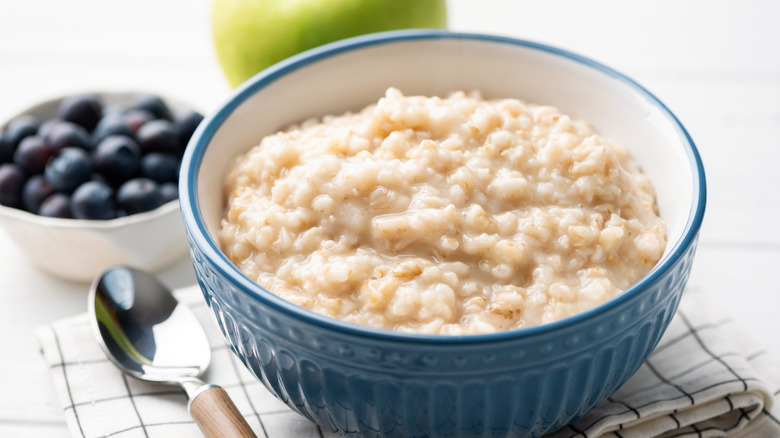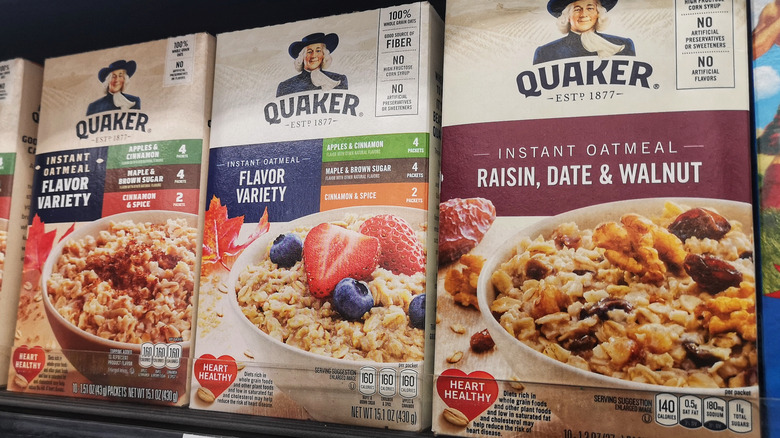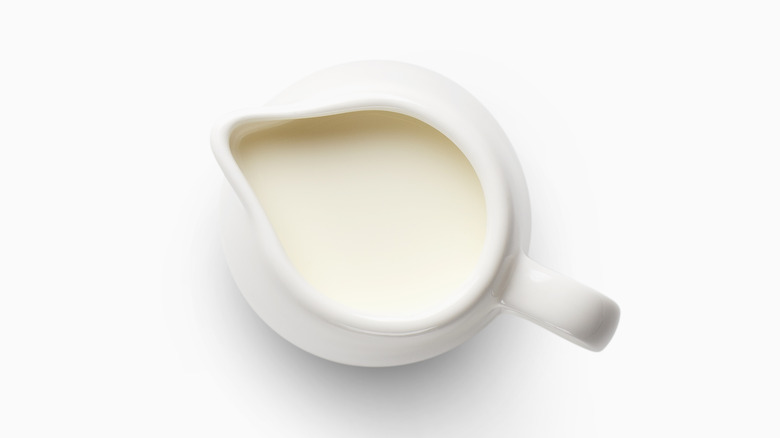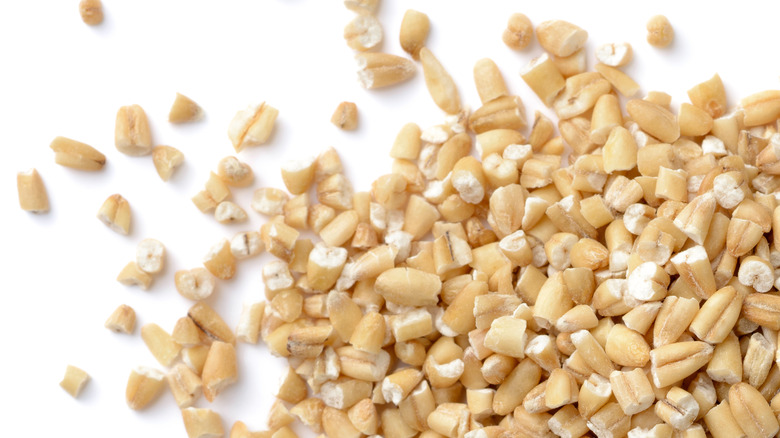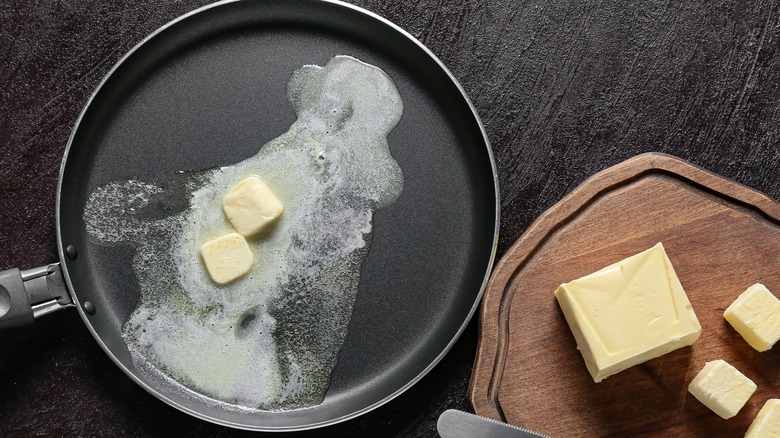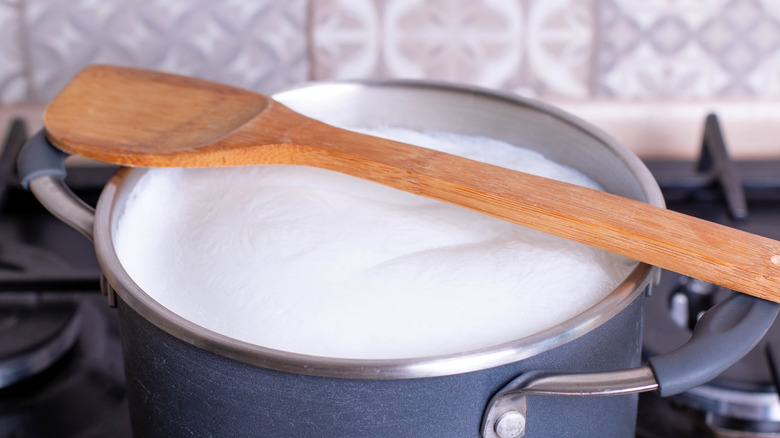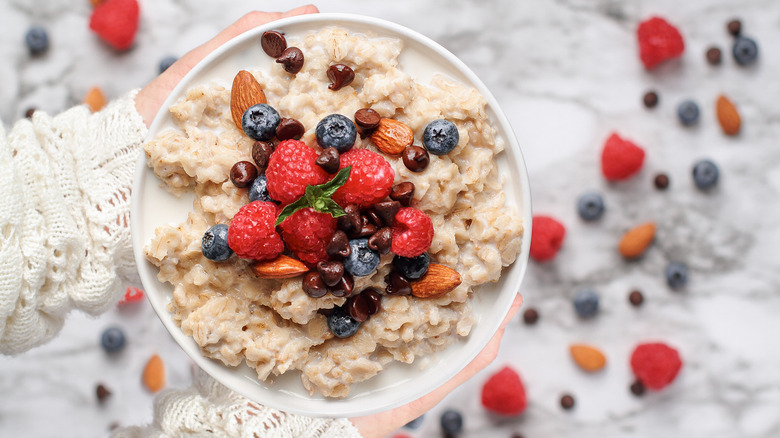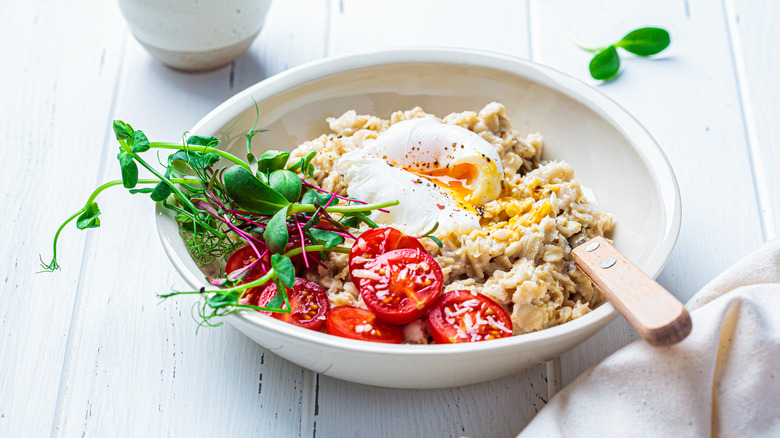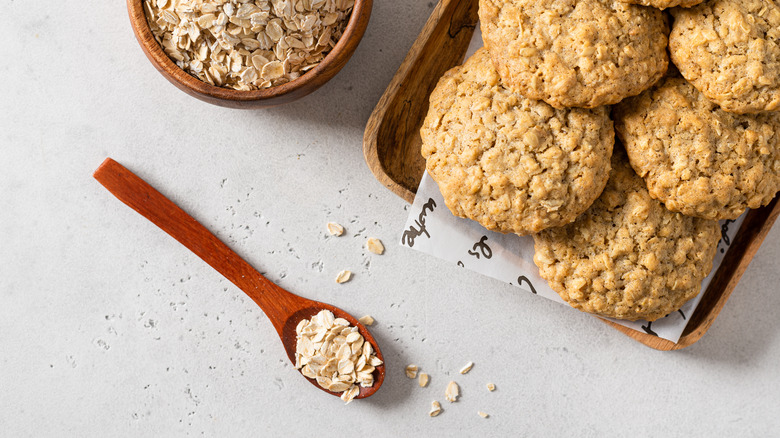Mistakes You Need To Avoid With Oatmeal
We may receive a commission on purchases made from links.
There are some surprising mistakes people can make with oatmeal. For example, the celebrated writer Samuel Johnson stuck his foot in it when he defined the word oats in 1755. His famed "Dictionary of the English Language" describes the cereal this way: "A grain, which in England is generally given to horses, but in Scotland supports the people." It was a mistake, not only because he offended quite a few Scots, but also because it was an untruth on two accounts. First, according to National Geographic, homo sapiens outside of Scotland have been eating porridge made from oats for around 33,000 years. Second, a July 1934 article in "Agricultural History" by Allen Walker Read presents evidence that Johnson himself, who was not a horse and did not live in Scotland, regularly ate oatmeal for breakfast as a child.
Not so surprisingly, though, most oatmeal mistakes have more to do with the preparation of the dish than discriminatory lexicology. Breakfasters have long been struggling to achieve the perfect texture and flavor, just a little bit chewy, not so gooey, and a hint of nuttiness. It's not hard to do, just avoid these mistakes.
1. Not eating oatmeal
Skipping oatmeal is, perhaps, the biggest oat-related error anyone could commit. This traditional breakfast food is delicious, stick-to-your-ribs-filling, and tremendously healthy. The World Health Organization specifically names oats when recommending that people include more whole-grain foods in their diets. That's not all, though.
The American Heart Association (AHA) is quick to tote the benefits of including oatmeal in one's diet. When referring to the amount of fiber in porridge, the organization says, "It's like the scene in a movie where oatmeal takes off its glasses and everyone realizes just how beautiful it is." There are also plenty of healthy nutrients found in a single cup of oatmeal: four grams of fiber, 15% of the daily requirement of vitamin B1, and ample manganese — 59% of the recommended daily intake for men and 76% for women.
The real reason the AHA loves oatmeal, though, is scientists have shown it lowers cholesterol. In 2008, Dr. James W. Anderson, professor of medicine and nutrition at the University of Kentucky, conducted a review of oatmeal research from the previous 15 years. Would the FDA heart-healthy label on oat-based foods hold its own? Over that period of time, every study examining the relationship between oats and cholesterol found that eating oats really does lower total cholesterol. " That's great news for the FDA logo, but also for oatmeal lovers everywhere.
2. Choosing the wrong oats
Anyone who's not digging their oats as expected may be choosing the wrong kind. It's easy to get confused. Here are some descriptions from Walmart's website: "whole grain old fashioned oats," "quick rolled oats," "one-minute oats," "three-minute oats," "steel-cut, traditional oats," "protein oats," and "instant oats." In all, there are more than 1,000 search results for oatmeal on the page.
Quaker explains that oats come in four basic varieties. There are steel-cut oats that you can prepare in a slow cooker overnight or on the stove for 20 to 30 minutes. They make toothsome, chewy porridge. Old-fashioned or rolled generally take 5 to 10 minutes to soften in a saucepan. Breakfasters can prepare quick-cook oats in just one minute. Finally, instant oats are ready after a quick spin in the microwave and have the smoothest texture.
According to New Food Magazine, each variety includes the whole oat and they all have nearly identical nutritional value. The difference is in their processing. First, machines chop the oats into smaller pieces. The larger the chopped pieces, the thicker the flakes will be and the longer their cook time. The most finely chopped become instant oats.
The balancing act is between texture and time. The oatmeal with the heartiest texture takes the longest to cook, while instant varieties become goo upon contact with hot water. If the consistency of oatmeal seems gross, try a thicker rolled oat or steel cut.
3. Only trying instant oatmeal packets
Instant oatmeal packets are a blessing for people with rushed morning routines. Pour in some boiling water and breakfast is ready. Voila! However, people who only eat porridge this way are missing out on new flavors, textures, and the opportunity to get creative with toppings. Breakfasters who leave behind the instant packages may rediscover this seemingly boring, beige food.
If time is of the essence first thing in the morning and stirring a pot of oatmeal for ten minutes seems like a waste of time, there are other options. Take overnight oats and baked oatmeal, for example. It's simple to mix up overnight oats before heading to bed — just mix milk, yogurt, rolled oats, and fruit in a jar. Then, stick it in the fridge.
Baked oatmeal takes even less effort. People can prepare this dish once a week or over the weekend. Dietitian May Zhu told Livestrong that using muffin tins is "great for those who want quick options that they can easily take on the go." Baked oatmeal simply adds eggs and baking powder to the other typical porridge ingredients. Then, just stick the pan in the oven and bake. In a few minutes, you'll have breakfast ready for the whole week.
4. Picking milk versus water for oatmeal
Oatmeal is such a basic food that few people question their oatmeal recipe. They just stick some oats and milk in a bowl or pot and heat it. Anyone who likes their oatmeal this way should continue doing what they're doing. Breakfasters who feel discontent with the product, though, may need to pay more attention to the process to create the perfect bowl of porridge. This brings up the heated milk versus water debate.
In an oatmeal-themed video on his Youtube channel, Chef Jamie Oliver uses water to prepare his morning porridge. He warns that cooking with milk or cream means the mix can burn and scald easily, ruining breakfast. He adds the oats to cold water, brings the mix to a boil, and turns down the heat. After serving it in a bowl, he marks some lines in it with a spoon and splashes some milk on top.
On the other hand, in an interview with Insider, Chef Nate Weir says, "Don't use just water. Using milk or almond milk, soy milk, etc., for part of the liquid makes oatmeal richer and creamier." He recommends trying half milk and half water, then adjusting until creating just the right texture.
Ultimately, every porridge eater will have to decide which liquid they prefer and experiment with other alternatives. How would oatmeal turn out using pineapple juice or tea as the base liquid?
5. Using too much or too little liquid in porridge
Much like the milk-water debate, the amount of liquid you add to oatmeal depends on personal taste. More milk or water will make oatmeal runnier and less liquid makes it thicker.
This classic porridge recipe calls for two parts liquid and one part oats. Jamie Oliver adds three cups of water for every cup of cereal, saying that it's the Scottish way of doing things. As a general rule, most recipes oscillate between two parts and three parts liquid.
If that seems confusing, breakfast cooks can follow the instructions that came with their oats, adding more liquid until their porridge is perfect. Just remember: it's far easier to add more milk to thick oatmeal than it is to take some out of a runny mix. And there's nothing as delicious as a splash of cool milk over thick, piping-hot oatmeal right before digging in.
6. Cooking steel-cut oats the wrong way
Steel-cut oats are a whole other story — cooking them takes a different process. Manufacturers steam old-fashioned oats before flattening them into flakes, but steel-cut oats simply get chopped into smaller pieces according to New Food Magazine. This cereal only becomes soft enough to eat if cooks take some extra steps in the preparation, for example, using a slow cooker, soaking the oats overnight, or using a pressure cooker.
Some cooks follow recipes like this one for overnight steel-cut oats. It says to soak steel-cut oats overnight for a total of 10 to 12 hours before heating them or eating them cold. That's the simplest process. Other recipes require kitchen equipment like pressure cookers and slow cookers. Gingerbread oatmeal calls for eight hours in a slow cooker. Put the ingredients in right before bed and wake up in the morning to a hot bowl of perfectly textured oatmeal. To make cinnamon roll steel-cut oats, on the other hand, put the cereal in a pressure cooker for around 10 minutes. Once it's done cooking, let it sit for another ten minutes before it's ready to scarf down. That's a lot quicker than soaking or running a slow cooker all night, but slightly more labor intensive.
7. Not toasting the oats
Some people may be skipping a step of the oatmeal-making process and that's toasting the oats before adding any liquid. Porridge comes out tasty without browning the oats, but anyone toasting can amp up the deliciousness.
Toasting oats means browning them slightly, in fat, before adding any liquid. The Prairie Oat Growers Association website, Oats Everyday, explains that cooks can do this on the stovetop or, for a bigger batch, in the oven. Chef Nate Weir told Insider, "To boost the flavor, toast the oats in melted butter — or even better, coconut oil — in a saucepan over medium heat, before adding liquid." You should keep the oats moving until they smell a bit like popcorn. It only takes a few minutes — around three according to this recipe. Chef Weir says toasting oats in a saucepan shouldn't add extra preparation time since the oats are already cooking while they brown.
8. Forgetting to add salt to oatmeal
Does porridge still seem bland no matter what you do? It could be that the salt is missing. Just a pinch of this miracle mineral makes sweet flavors taste sweeter and gives oats a nice nutty nuance, so be sure to remember it.
In her book, "Salt, Fat, Acid, Heat," Samin Nosrat wrote this general rule: "A smaller amount of salt applied while cooking will often do more to improve flavor than a larger amount added at the table." That means the moment to add salt to oatmeal is as the water or milk heats in a saucepan on the stove, not after spooning it into a bowl. Adding the salt earlier ensures the flavor will mix more completely through the porridge.
Chefs Jamie Oliver and Nate Weir agree about the fundamental role of salt. "Very, very important," says Oliver as he sprinkles on sea salt after adding water to his pot. In his Insider interview, Weir says, "You should season your oatmeal with salt. Just a little pinch at the beginning of cooking will help bring out the flavor."
9. Letting oatmeal boil over
The saying goes, "A watched pot never boils." The missing half of the refrain should be, "And unwatched pots have a way of boiling over every time." You turn away momentarily to check a recipe or grab a missing ingredient and as soon as your attention is back on their oatmeal, you see white froth bubbling over creating a disaster all over the stovetop. It can happen in the microwave as well.
To make things worse, oatmeal is notoriously difficult to clean up once it dries on, so even if breakfasters are in a morning rush, they'll have to stop and scrub up the gloopy mess. Jamie Oliver says, "If it boils over and goes on the cooking range it's really hard to clean and it stinks the house out." He recommends using a high-sided pot and avoiding milk in the stove-top mixture. He also stirs his porridge while it's cooking to break up the bubbles.
Cook's Illustrated has sage advice for preventing spills in the microwave — use a bigger bowl and stop the microwave to stir it a couple of times. They also explored other options like adding butter, putting chopsticks across the top of the bowl, and using a lower power to cook oatmeal. Adding fat changes the chemistry of the mix so there are fewer bubbles, but for it to work you need to add more than two tablespoons of butter to one bowl of oatmeal. That's too much! Chopsticks did little to stop porridge from bubbling up and out of the bowl while using a lower power in the microwave gave good results.
10. Eating oatmeal plain
World-famous porridge makers (yes, they exist) know one thing: it's a sin to eat porridge plain. According to the BBC, every year, the best of the best gather in Carrbridge, Scotland, to compete for the Golden Spurtle. The Merriam Webster Dictionary defines a spurtle as "a wooden stick for stirring porridge" and says the term is mainly used in Scotland. A golden one is a fitting trophy for the World Porridge Making Championship. The participants go wild with their toppings in the Specialty Porridge Section as they vie for the coveted object.
Winning recipes have included the usual suspects: nuts, blueberries, cranberries, coconut, and chocolate. Other winning garnishes are a bit more surprising: Mexican mole, whiskey, pineapple, spinach, mushrooms, and gooseberries. Since oatmeal is bland, it combines well with most other flavors, whether salty or sweet. Adding something crunchy offsets its famously gloopy texture. So, oatmeal makers may want to whip up their own version of pecan and maple, piña colada, or caramel sweet and sour porridge — each were winning combinations in the championship. Just keep in mind: there's no wrong topping for oatmeal.
11. Never trying savory oatmeal
Sweet porridge is famous, but savory oatmeal may sound like a novel idea to many. Instead of adding brown sugar, some cooks add mushrooms, fried eggs, cheese, bacon, and even fish while broth replaces creamy milk.
In an interview with Bon Appetit, Chef Justin Devillier explained that savory porridges made from non-oat grains are traditional in some parts of the world. In the Southern United States, cooks serve grits savory, not sweet. The same is true of congee, a rice porridge from Asia. It's not a huge jump to believe that savory oatmeal could become wildly popular.
In a demonstration, aired on ABC7 News Bay Area, Chef Kathy Fang says that swapping the rice in traditional Chinese congee with quick oats means she can prepare breakfast in five or six minutes instead of waiting for slower-cooking rice. She describes the dih as "total comfort food ... We've got some ponzu, chia seeds, ... some toasted nori, and then chili oil to pump it up a couple notches."
If seaweed and chia don't sound appealing, why not whip up some savory oatmeal with sausage, kale, radishes, parmesan cheese, and fried eggs? People should try everything at least once.
12. Only using oats to make porridge
There may be some people who still don't like oatmeal in any variation. That's ok, but they should still get their oats on. After all, this grain can do far more than just make creamy porridge.
You can incorporate oats into meals and desserts in so many ways. There are oatmeal fruit bars, oatmeal cookies, baked oatmeal, yogurt parfaits, and granola. Cooks Illustrated suggests using oats to thicken soup. The ideas are endless and all it takes is a quick search to find them.
Another benefit of oats is that they're gluten-free when processed separately from wheat products, according to a 2016 statement made by the North American Society for the Study of Celiac Disease. That means that using them in baking produces treats that everyone in the family can share — even those on gluten-free diets.
Porridge and oats are nutritious, filling, and delicious, especially if people avoid making oatmeal mistakes. Finally, oats are not just for horses, so it's time to use those spurtles and whip up some fantastic breakfast.
